In the heart of the ever-evolving healthcare industry, content marketing for healthcare can define the bridge between organizations and patient engagement. This guide unveils 10 vital content marketing ideas, tailor-made for healthcare providers, to captivate and educate their audiences — ensuring your message not only reaches but also resonates. Let’s explore how these strategies can enhance your healthcare content marketing efforts and build lasting relationships with your patients.
What is Content Marketing for Healthcare Organizations?
Content marketing for healthcare involves creating and sharing valuable, relevant content to attract, inform, and engage a defined target audience, with the ultimate goal of driving profitable patient action. Unlike traditional marketing, it is less about selling services directly and more about initiating conversations, providing knowledge, and building trust with potential patients and the wider community.
Healthcare providers have a unique opportunity to leverage content as a primary source of engagement and education. Correctly executed, the ROI of content marketing can be significant, not just in terms of patient numbers but in how the healthcare service is perceived in the digital sphere.
How Content Marketing is Useful for Healthcare Organizations?
Content marketing isn’t just a buzzword; it’s a necessity in a healthcare organization’s communication strategy. It’s about delivering the right message to your audience of patients at the right time. Effective healthcare content marketing allows organizations to:
- Build Community: Creating high-quality, informative content allows healthcare organizations to better engage with current patients and attract new ones. This builds a community centered around their expertise.
- Boost Search Traffic: Content marketing improves the online experience for patients searching for health information, ensuring your organization’s topics appear at the top of search results.
- Strengthen Social Presence: Sharing content on social media expands your audience reach and allows you to directly interact with patients online.
- Enhance Patient Education: Educational content empowers patients to make informed healthcare decisions by increasing their knowledge about conditions, treatments, and healthy living.
- Showcase Expertise: Consistent valuable content positions your organization as an industry leader and authority in healthcare.
- Build Trust: The right content builds patient trust in your organization as a reliable source of medical advice and support.
- Support Mental Health: Addressing mental health concerns through supportive content positively impacts community well-being.
- Manage Reputation: Engaging with patients online helps manage your reputation and foster loyalty.
- Increase Organic Traffic: Quality content attracts more organic search traffic without a large paid advertising budget.
- Address Privacy: Educating patients about privacy practices reassures them their health data is secure.
What Content Marketing Channels are Available to Healthcare Organizations?
Healthcare providers can dive into various digital marketing channels to publish and promote their content. Each channel serves a unique purpose in a healthcare content marketing strategy, and utilizing a mix can amplify reach and engagement. Here are some key channels for distributing healthcare content:
- Websites: The foundation of digital presence, where patients often start their journey. It must be user-friendly and SEO-optimized to attract organic traffic from search engines.
- Blogs: Helpful for deep dives into healthcare topics, sharing patient stories, or highlighting industry news, blogs boost search visibility and provide valuable content.
- Social Media Platforms: Sites like Facebook, Twitter, and Instagram allow for direct patient engagement, real-time updates, and the distribution of diverse forms of content, from short-form videos to infographics.
- Email Newsletters: A personal touch for delivering updates, advice, and healthcare tips directly to patients’ inboxes, ensuring ongoing communication.
- Video Content: Explainer videos on platforms like YouTube can demystify complex procedures and promote healthy lifestyles, making medical content more accessible.
- Webinars and Live Sessions: Interactive sessions with medical professionals can foster real-time patient engagement and answer common questions.
- Podcasts: Emerging as a popular medium, podcasts allow for in-depth discussions on healthcare topics, offering a personal connection with listeners.
- E-books and Whitepapers: In-depth, authoritative sources of information on specific healthcare issues, treatments, or innovations.
Leveraging these channels allows healthcare providers to offer a user experience tailored to their target market’s preferences and needs. Through varied and customer-centric content, organizations can connect with their audience effectively.
For healthcare organizations looking to optimize their efforts in these areas, there are ample resources. For instance, understanding how to craft SEO-friendly landing pages through our guides like How to Optimize Landing Page for SEO can significantly benefit your healthcare website’s visibility to those seeking medical information.
What Do Your Patients Expect from Your Healthcare Organization?
Navigating the landscape of the healthcare industry requires an understanding of the audience’s hopes and fears. When it comes to content, here’s what prospective patients and the wider audience look for:
- Reliability: Use reliable, up-to-date information from authoritative sources reflecting current medical advice.
- Empathy: Show empathy by addressing patient concerns and sensitively discussing healthcare topics.
- Accessibility: Make content accessible for all health literacy levels using simple, easy-to-understand language.
- Engagement: Foster engagement through interactive content like blog comments and social media discussions.
- Diversity of Topics: Cover diverse healthcare topics beyond common conditions, including wellness and preventive care.
- Transparency: Communicate transparently about services, pricing, privacy, and patient expectations.
- Support: Offer guidance on navigating healthcare services, insurance, and healthy lifestyles.
- Personalization: Personalize content by tailoring advice to specific conditions and patient needs.
Paying attention to these expectations can help healthcare organizations shape their content marketing efforts, drawing on resources like B2B SaaS content marketing to fine-tune their approach for more specialized services or clinical software offerings.
Idea #1: Share Real Patient Stories to Inspire and Build Trust
Personal stories have the power to transform statistics into something that tugs at the heartstrings. By sharing patient stories, healthcare organizations can instill hope, encourage empathy, and demonstrate accountability and successful outcomes.
Objective
To enhance patient engagement and showcase real-life examples of exceptional patient care and recovery, fostering a powerful emotional connection with your audience.
What needs to be done
- Obtain consent from patients to share their stories.
- Collaborate with medical professionals to ensure stories are accurate and respectful of patient privacy.
- Develop engaging narratives that highlight overcoming challenges and the role of healthcare services in changing lives.
Example
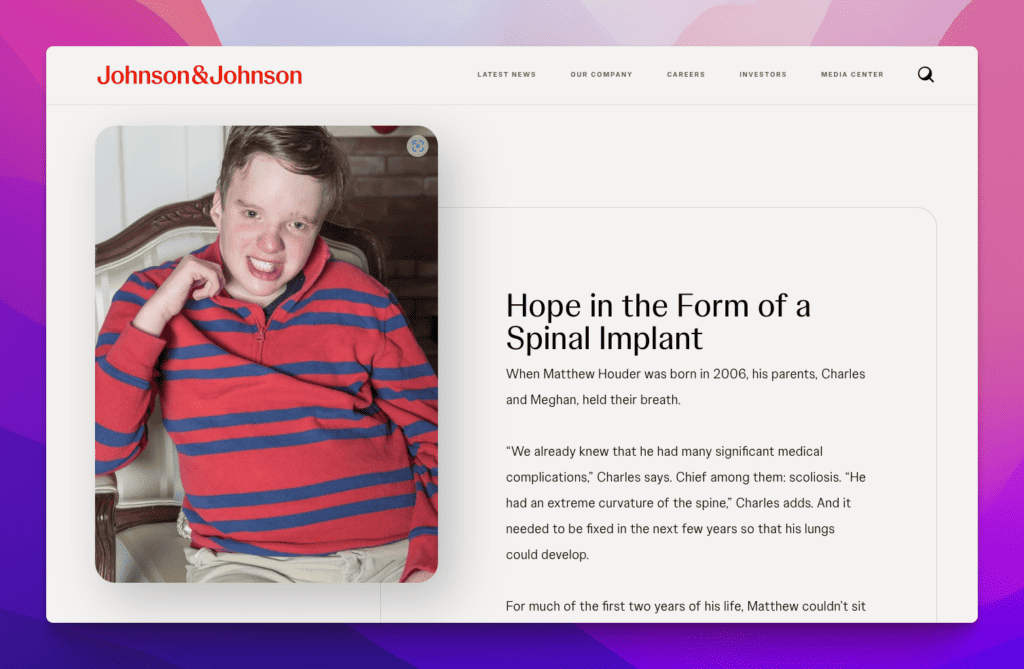
Johnson & Johnson is deeply committed to improving people’s health and quality of life. Through inspirational patient stories, like a young boy who found hope in spinal surgery and a woman who overcame a stroke at 37, Johnson & Johnson demonstrates its dedication to putting patients first. These stories exemplify the company’s ethos and commitment to high-quality healthcare for over 75 years.
Captivating patient stories align with the notion that content marketing can increase sales—by displaying genuine experiences, organizations can strengthen trust and preference for their services. For insights into how content builds sales, you can read Can Content Marketing Help Increase Sales?.
Idea #2: Create Health Awareness Campaigns
Healthcare providers can maximize impact by launching campaigns that raise awareness about critical health issues, preventive measures, and the importance of regular check-ups.
Objective
To inform the public about health risks, preventive practices, and to encourage proactive personal health management.
What needs to be done
- Identify relevant healthcare topics and common questions that need awareness.
- Develop informative and timely content that educates and prompts readers to take action.
- Use various content formats like infographics, social media posts, and explainer videos for broader reach.
Example
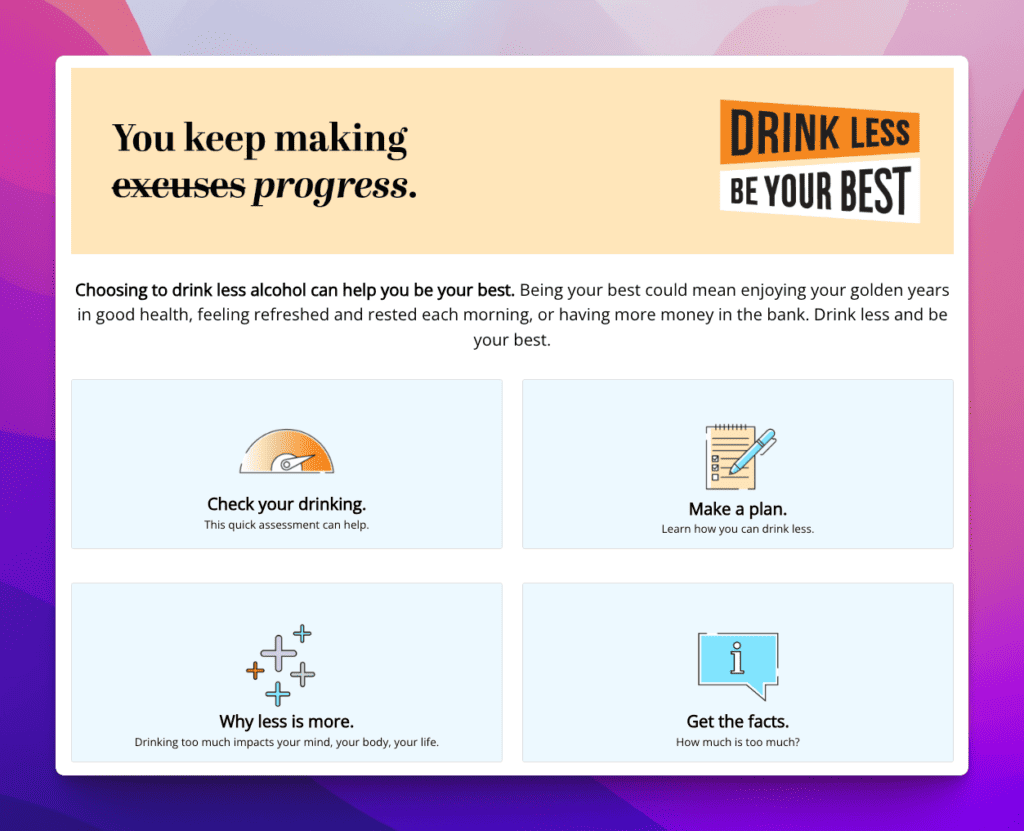
The CDC’s “Drink Less, Be Your Best” campaign effectively raises awareness about the health risks of excessive alcohol consumption. By encouraging people to reflect on their drinking habits, make a plan to reduce consumption, and highlighting the benefits of moderation, the campaign promotes healthier choices. It serves as a model for healthcare providers to educate and motivate the public to take preventive steps for better health.
Idea #3: Host Live Q&A Sessions with Healthcare Professionals
Interactive live sessions are an excellent way to address patient questions in real-time, making healthcare professionals more accessible and approachable.
Objective
To diminish patient anxiety by offering expert advice and actionable guidance directly from healthcare professionals, thus enhancing the patient experience and easing communication.
What needs to be done
- Schedule regular live sessions on social media platforms where there is active user participation.
- Prepare topics that resonate with current healthcare conversations and concerns.
- Promote these sessions in advance to amplify attendance and prepare users to bring their own questions.
Example
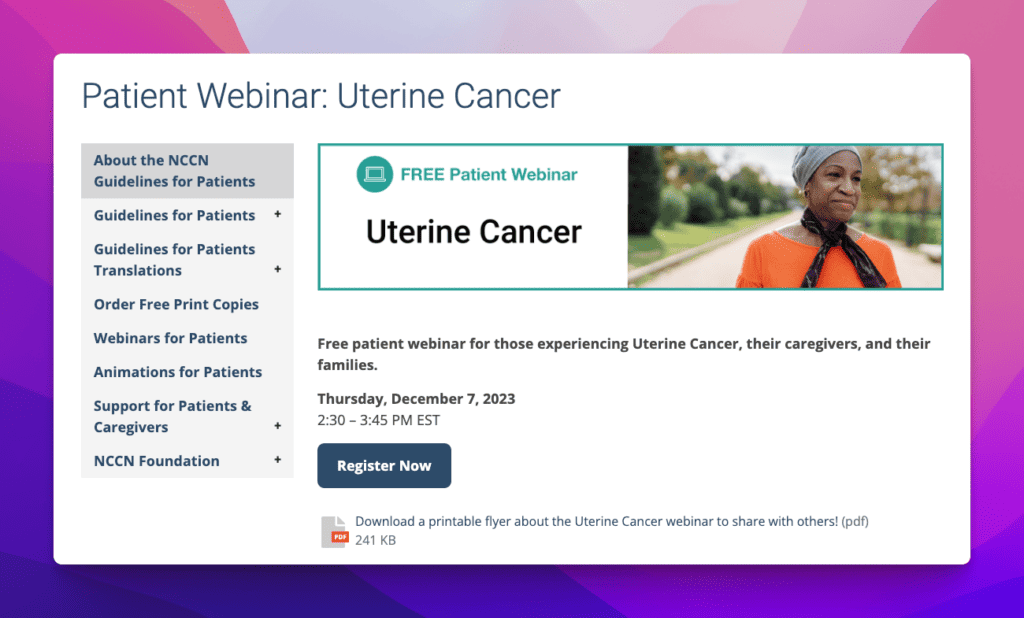
The free patient webinar for those affected by uterine cancer provides an interactive platform to engage with healthcare professionals, ask questions, and gain understanding of treatments, side effects, and resources. This live Q&A session fosters accessibility and approachability in healthcare.
Idea #4: Develop a Series of ‘How-To’ Educational Videos
Videos are a compelling way to break down complex health topics into digestible, actionable steps. They’re a key tool in patient education and engagement.
Objective
To enhance patient knowledge on managing personal health and to simplify the understanding of medical procedures or health advice.
What needs to be done
- Identify common procedures or advice that could benefit from a visual, step-by-step tutorial.
- Create high-quality video content that patients can easily follow and learn from.
- Ensure videos are accessible across all digital channels, especially social platforms where your patients are most active.
Example
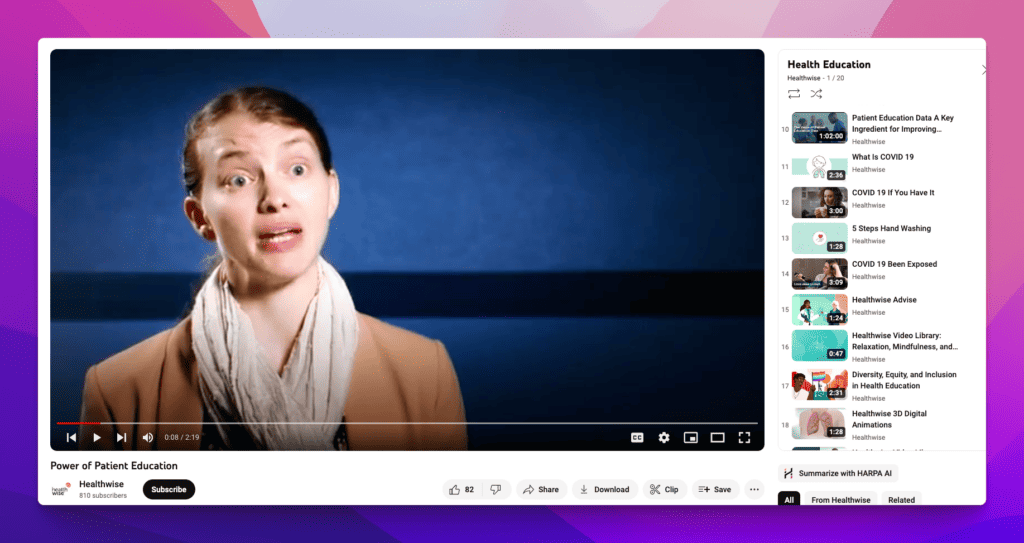
Healthwise’s “How-To” videos excel at breaking down complex health topics into digestible, actionable steps. By using visual and informative content, they empower patients to understand and engage with their health. The educational videos make important information accessible and comprehendible, significantly contributing to patient education and engagement.
These ‘How-To’ video series can significantly reduce patient anxiety by providing them with the know-how to manage their health confidently. It allows healthcare providers to extend their care beyond the clinic, directly into the patient’s daily routine.
Idea #5: Run a “Myth vs. Fact” Social Media Campaign
Combat misinformation by distinguishing myths from facts, which is crucial in the healthcare industry, especially on social media platforms where misinformation can spread quickly.
Objective
To clarify misconceptions, promote evidence-based information, and build an informed patient base equipped with factual knowledge to make health decisions.
What needs to be done
- Compile a list of common myths and misconceptions related to healthcare.
- Craft posts that juxtapose myths with facts, presented in a clear and engaging format.
- Encourage social shares to increase the reach of accurate information.
Example

The “Myths and Facts about COVID-19” page by the Department of Health in South Africa effectively contrasts common myths with factual evidence to combat misinformation. The simple visual format allows facts to be easily shared on social media to counter false claims about COVID-19. Proactively addressing myths this way promotes accurate knowledge and informed health decisions.
Idea #6: Publish a Weekly “Health News Round-Up” Blog Post
Keeping your audience informed about the latest in health news can position your organization as the go-to source for trusted and timely content.
Objective
To provide a curated selection of recent healthcare news, studies, and trends that keeps your audience updated and demonstrates your organization’s pulse on the industry.
What needs to be done
- Monitor and select relevant healthcare news from authoritative sources and studies.
- Summarize the news in an easy-to-read format, providing context and expert commentary from your healthcare professionals.
- Post consistently on your blog, with an option for readers to subscribe for updates.
Example
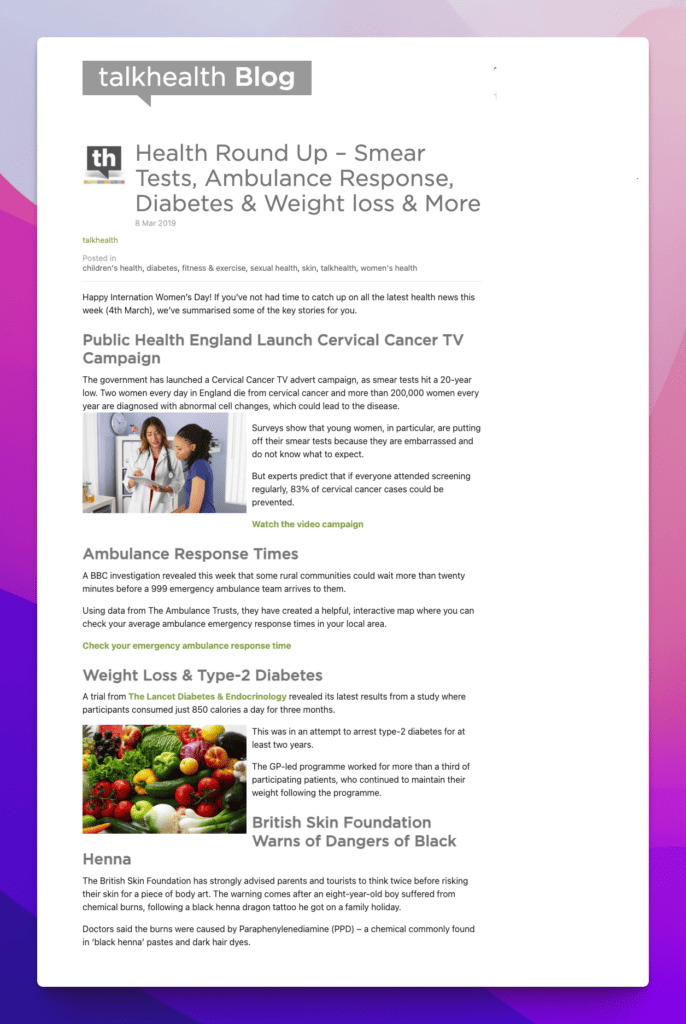
This weekly health news round-up post by Talk Health summarizes key stories to keep readers informed of the latest developments. By highlighting relevant news, it establishes the blog as a reliable, up-to-date source for health information, building trust and credibility among readers seeking timely content.
Idea #7: Launch a “Question of the Week” Interactive Series
Engage with your audience by addressing their specific healthcare questions, demonstrating attentiveness and a dedication to educating the public.
Objective
To create an ongoing dialogue with prospective and current patients by offering trustworthy advice on frequently asked medical questions in a relatable and easy-to-understand way.
What needs to be done
- Solicit questions from patients and social media followers on a weekly basis.
- Select one or more common questions and provide in-depth answers via blog posts, social media updates, or videos.
- Promote the series across your content marketing channels to encourage interaction and submission of new questions.
Example

The “Question of the Week” campaign from Cloudnine Hospital on Facebook engages audiences by inviting parenting questions on important health topics like breastfeeding. By providing a platform to share experiences and concerns, it fosters community support. Addressing specific questions demonstrates attentiveness to patient needs and a commitment to public health education. This approach builds trust and promotes learning and sharing within the community.
Idea #8: Feature Wellness Tips and Healthy Lifestyle Content
Promoting overall well-being goes a long way in preventive care, and wellness tips are the perfect content to encourage healthy choices among patients.
Objective
To inspire your audience to prioritize their wellness through practical and actionable advice, thereby contributing to a healthier community and reducing future healthcare burdens.
What needs to be done
- Develop a series of content pieces around wellness, such as stress management, exercise, nutrition, and sleep.
- Share these tips in diverse formats, such as blog posts, infographics, or video content, to cater to different learning preferences.
- Partner with professionals within your organization, like dietitians and physiotherapists, to lend credibility and variety to the content.
Example

The article by Four Wellness Co. features 31 simple wellness tips that seamlessly promote overall well-being and preventive care. Covering various aspects of health from hydration to mental well-being, it serves as an excellent example of a lifestyle piece encouraging healthy choices.
By offering wellness tips, healthcare organizations not only contribute to the immediate health of individuals but also establish a rapport as proactive advocates for long-term health and well-being.
Idea #9: Generate Informative Infographics on Health Statistics
Infographics can transform complex data and statistics into visual, easy-to-understand formats that engage and educate readers.
Objective
To present health statistics and important data-driven insights in a visually appealing and simplified manner, aiding in patient understanding and retention of information.
What needs to be done
- Gather accurate and current data that is relevant to your audience’s health interests or concerns.
- Work with graphic designers to create infographics that are clear, compelling, and on-brand.
- Disseminate these infographics through your website, social media channels, and in informative email newsletters.
Example

The “Lyme Disease: An Ongoing Concern” infographic by Fair Health exemplifies transforming complex health statistics into a visually compelling, easily understandable format. Through engaging charts, graphs, and text, it conveys crucial information about the prevalence, impact, and concerns related to Lyme disease. This demonstrates the power of infographics to educate audiences and raise awareness by simplifying intricate data.
Creating content that resonates with users while providing educational value can be challenging, but agencies that specialize in content marketing could lend a valuable perspective. Exploring options from the list provided in Content Creation Agency – 7 Companies Rated could help in finding the right expertise for crafting effective infographics.
Idea #10: Curate a Series of Expert Roundtable Discussions
Roundtable discussions with experts provide a platform for deep dives into complex healthcare subjects, offering diverse perspectives and rich insights.
Objective
To foster a comprehensive understanding of multifaceted healthcare issues and to introduce patients to the professionals behind their care.
What needs to be done
- Identify pressing healthcare topics that warrant in-depth discussion.
- Assemble a panel of experts from various specialties within your organization to offer a well-rounded discourse.
- Record these sessions for distribution via podcasts, video content, or blogs, ensuring they are readily available to your audience.
Example
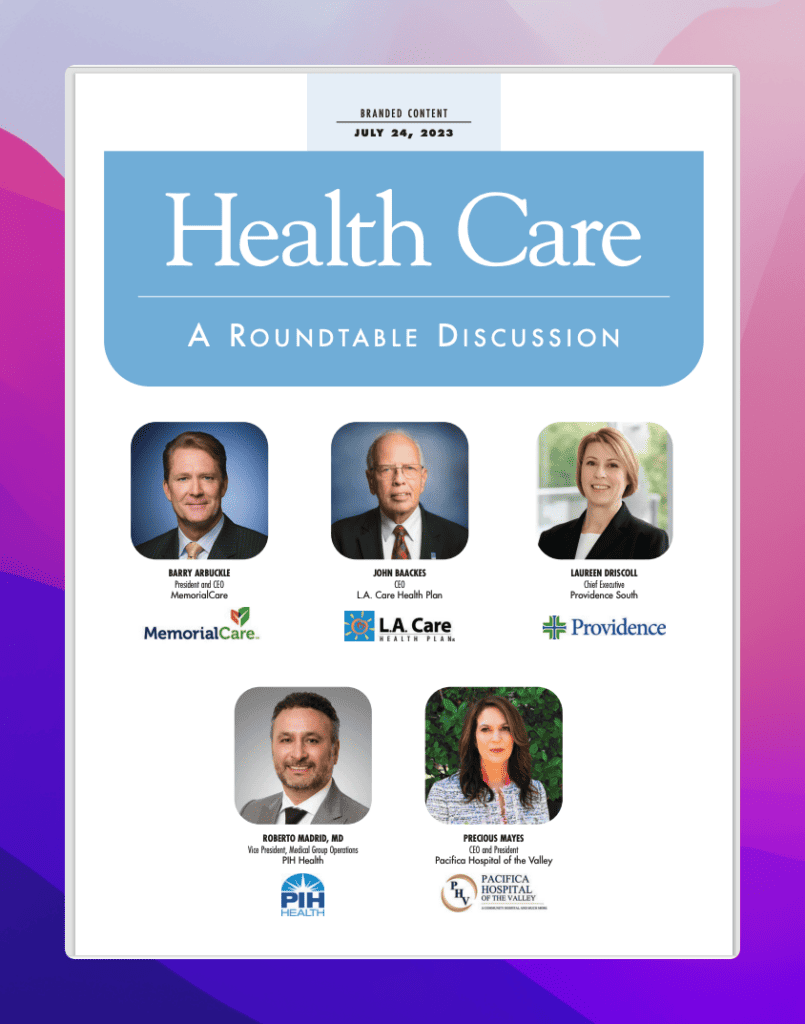
“Healthcare: A Roundtable Discussion” exemplifies curating expert roundtable events by convening thought leaders to explore complex healthcare subjects. This platform enables in-depth examination from diverse perspectives, generating insights into industry challenges and opportunities. Through insightful conversations, it addresses pressing health issues, providing valuable knowledge to benefit the region and beyond.
For a healthcare marketing team looking to create content that resonates and retains interest, it might be useful to consider the strategy and approach details provided by Content Marketing Help Increase Sales, as it can reveal how engaging discussions might indirectly foster a stronger commitment from patients towards the healthcare provider.
Takeaways from these Content Marketing Strategies
At its core, successful healthcare content marketing is about forming meaningful connections with your audience. Whether through patient stories, health campaigns, or expert discussions, each content strategy should enrich your overall plan.
Key Takeaways:
- Authentic Engagement: Content centered on real patient interactions like storytelling, Q&As, and wellness challenges fosters genuine connections.
- Educational Value: Informative content positions your organization as a trusted educator and leader in healthcare.
- Visual Appeal: Visual formats like infographics and videos convey complex data clearly, increasing social shares and comprehension.
- Expertise Highlighted: Discussions and sessions showcase the depth of your organization’s knowledge, reassuring patients.
Implementing these strategies requires understanding your target audience and committing to relevant, high-quality, timely content. Communicating effectively with patients through content is critical to a healthcare organization’s digital success.
For a broader perspective, exploring resources like Can Content Marketing Increase Sales? provides insight into how a strong content strategy can inform, educate, and contribute to organizational growth.
Boost Your Content Marketing
If your healthcare content marketing strategy needs a revamp, it may be time to get expert guidance. Whether refining your overall plan, improving SEO, or reenergizing social media, professional support can make a big difference.
Ways to Get Help:
- Define Your Brand Voice: Crafting a unique voice is key for standing out. Let experts help articulate your brand message.
- Utilize User Content: Encourage and leverage patient reviews and testimonials to build trust and authenticity.
- Optimize for Search: Improving search visibility is critical for attracting patients. SEO pros can boost your rankings.
- Maximize Social Media: Create compelling social campaigns that resonate with your audience. Harness social platforms to connect.
- Leverage Email Marketing: Well-executed email campaigns keep patients engaged long-term with valuable updates.
For assistance in these areas and to further enhance your initiatives, connect with an experienced team to transform your healthcare content marketing approach. Reach out to Paretoid and take the first step toward tailored support.
FAQs
Enhancing your content marketing strategy often starts by addressing key questions. Let’s tackle some of the most common queries regarding healthcare marketing:
What are the 4 P’s of healthcare marketing?
The 4 P’s stand for Product, Price, Place, and Promotion. In healthcare:
- Product refers to the services or treatments offered.
- Price is about cost transparency and value.
- Place means the distribution channels, including clinics and digital platforms.
- Promotion involves the ways you inform and engage potential patients about your services.
What is the SEO strategy for the healthcare industry?
An SEO strategy for healthcare should include:
- Keyword research focused on medical terms and patient concerns.
- Creating relevant, high-quality, and informative content.
- Optimizing website structure and content for search engines.
- Building authoritative backlinks.
Why is SEO important in healthcare?
SEO makes your healthcare organization more visible to those seeking medical information or services. It helps place your website at the top of search results, increasing the likelihood of patient engagement.
Why is healthcare marketing important?
Marketing in healthcare is essential for patient education, engagement, and for healthcare providers to communicate the value of their services. Good marketing strategies also keep organizations competitive and can help in expanding their patient base.
How do you measure success in healthcare marketing?
Success can be measured through:
- Increased patient volume and retention rates.
- Enhanced online presence and search rankings.
- Patient feedback and satisfaction surveys.
- Social media engagement and shares.
- Return on investment (ROI) of content marketing.
